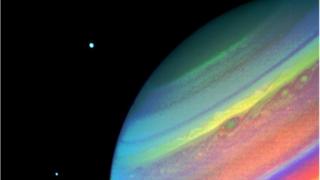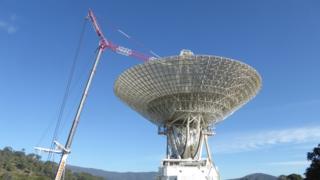
[ad_1]
 MPI
MPIAn illustration of Voyager 2
Scientists who had not been able to command the Voyager 2 spacecraft in the past eight months have returned to it.
It’s because the radio antenna – Deep Space Station 43 in Australia – had to be turned off for major repairs. It is the only dish in the world that can send commands to Voyager 2.
Test messages were sent on October 29 and the probe “picked up” the cosmic call and carried out its commands without any problem.
It took a while though, the team had to wait more than 34 hours for a response, much longer than the 16 hours normally required.
The spacecraft has yet to send health data and updates, but NASA hasn’t been able to tell it to do anything while the antenna was offline.
Voyager 2
Voyager 2 is a 43-year-old space probe originally launched into space in 1977 with a mission to explore the outer planets of the solar system. The probe is part of a pair sent to investigate space.
Since its launch it has traveled billions of miles away from Earth and is outside the Sun’s heliosphere, which is the protective bubble of particles and magnetic fields created by the Sun that surrounds the planets and the Kuiper belt.
The spacecraft is now more than 11.6 billion miles (18.8 billion kilometers) from Earth.
It has since continued to travel farther than our solar system and continues to drift into space deeper than its creators initially thought it would be able to.
You’ve probably seen the work of Voyager 2 before, it took some of the most famous and detailed images of the Earth’s neighborhood as it passed through Jupiter, Saturn, Uranus and Neptune.
 NASA
NASAThis image of Saturn was taken by Voyager 2
Like its twin, Voyager 1, it carries on its journey a “gold record”.
This disc contains recordings of sounds on Earth, information about humans, and most importantly, instructions on how to play it for all the lucky aliens who find it.
 NASA
NASADeep Space Station 43 is the only dish that can send commands to Voyager 2, it has been under repair since March
Major repairs
Repairs to Deep Space Station 43 are extensive and will not be completed until February 2021.
“What makes this task unique is that we are working at all levels of the antenna, from the pedestal at ground level to the feedcones in the center of the dish that extend over the edge,” said Brad Arnold, project manager DSN at NASA’s Jet Propulsion Lab in Southern California.
“This test communication with Voyager 2 definitely tells us that things are in line with the work we are doing,” he said.
Source link